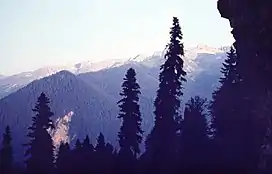Bzyb Range
Bzyb Mountain Range[1] (Abkhaz: Агеишьха, Ageish'kha; Georgian: ბზიფის ქედი) is a mountain range in Abkhazia on the southern slope of the western part of Greater Caucasus. The ridge is about 50 km long.
| Bzyb Range | |
|---|---|
 View of Bzyb Range from north side. | |
| Highest point | |
| Peak | Khimsa |
| Elevation | 3,032 m (9,948 ft) |
| Coordinates | 43°16′27″N 41°11′51″E |
| Dimensions | |
| Length | 50 km (31 mi) |
| Geography | |
  | |
| Country | Georgia |
| Region | Abkhazia[note 1] |
| Range coordinates | 43°18′N 40°55′E |
| Parent range | Caucasus Mountains |
| Borders on | Greater Caucasus |
Geography
The Bzyb Range's length is about 50 km and elevation is up to 3,033 m, it is made mainly of limestone with pronounced karst landscape. It is bounded by the valley of the Bzyb River from the north and west and partially by the valley of Kelasuri River, which separates it from the Abkhaz Range.
The highest point is mountain Khimsa (3032 m),[2] the second highest is Mount Dzishra (2623 m).[3] There are a number of passes, including Dow - 1387 m, Himsa - 2454 m, Gudauta. The ridge contains many karst wells, mines and caves.
From the north and west it is delimited by the Bzyb river valley, from the east - by a slight depression behind the mountain Himsa (Amtkel pass) and the river valley Amtkel, delimiting it from Abkhaz Range. To the south, it gradually decreases to the Black Sea plains. The northern slope of the ridge is steep, the southern slope is gentle and is divided into separate spur and river valleys of Hipsta, Aapsta, Western Gumista , Eastern Gumista, Kelasur.
Flora
Bzyb Range slopes are covered with broadleaved and coniferous forests. At a higher elevations there are alpine meadows.
Tourist attractions
One of the attractions is the Snezhnaya (Snowy) Cave, the most speleologically complex in the whole former Soviet Union. It is the fourth in the list of deepest caves in the world.

See also
Notes
- The political status of Abkhazia is disputed. Having unilaterally declared independence from Georgia in 1992, Abkhazia is formally recognised as an independent state by 5 UN member states (two other states previously recognised it but then withdrew their recognition), while the remainder of the international community recognizes it as as de jure Georgian territory. Georgia continues to claim the area as its own territory, designating it as Russian-occupied territory.